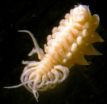(Press-News.org)
VIDEO:
In this animation, stunning aurorae ripple around a "hot Jupiter. " When a stellar eruption known as a coronal mass ejection hit the planet, it triggered these aurorae, which are the...
Click here for more information.
Earth's aurorae, or Northern and Southern Lights, provide a dazzling light show to people living in the polar regions. Shimmering curtains of green and red undulate across the sky like a living thing. New research shows that aurorae on distant "hot Jupiters" could be 100-1000 times brighter than Earthly aurorae. They also would ripple from equator to poles (due to the planet's proximity to any stellar eruptions), treating the entire planet to an otherworldly spectacle.
"I'd love to get a reservation on a tour to see these aurorae!" said lead author Ofer Cohen, a SHINE-NSF postdoctoral fellow at the Harvard-Smithsonian Center for Astrophysics (CfA).
Earth's aurorae are created when energetic particles from the Sun slam into our planet's magnetic field. The field guides solar particles toward the poles, where they smash into Earth's atmosphere, causing air molecules to glow like a neon sign. The same process can occur on planets orbiting distant stars, known as exoplanets.
Particularly strong aurorae result when Earth is hit by a coronal mass ejection or CME - a gigantic blast that sends billions of tons of solar plasma (electrically charged, hot gas) into the solar system. A CME can disrupt Earth's magnetosphere - the bubble of space protected by Earth's magnetic field - causing a geomagnetic storm. In 1989, a CME hit Earth with such force that the resulting geomagnetic storm blacked out huge regions of Quebec.
Cohen and his colleagues used computer models to study what would happen if a gas giant in a close orbit, just a few million miles from its star, were hit by a stellar eruption. He wanted to learn the effect on the exoplanet's atmosphere and surrounding magnetosphere.
The alien gas giant would be subjected to extreme forces. In our solar system, a CME spreads out as it travels through space, so it's more diffuse once it reaches us. A "hot Jupiter" would feel a stronger and more focused blast, like the difference between being 100 miles from an erupting volcano or one mile away.
"The impact to the exoplanet would be completely different than what we see in our solar system, and much more violent," said co-author Vinay Kashyap of CfA.
In the model, a CME hits the "hot Jupiter" and weakens its magnetic shield. Then CME particles reach the gas giant's atmosphere. Its aurora lights up in a ring around the equator, 100-1000 times more energetic than Earthly aurorae. Over the course of about 6 hours, the aurora then ripples up and down toward the planet's north and south poles before gradually fading away.
Despite the extreme forces involved, the exoplanet's magnetic field shields its atmosphere from erosion.
"Our calculations show how well the planet's protective mechanism works," explained Cohen. "Even a planet with a magnetic field much weaker than Jupiter's would stay relatively safe."
This work has important implications for the habitability of rocky worlds orbiting distant stars. Since red dwarf stars are the most common stars in our galaxy, astronomers have suggested focusing on them in the search for Earthlike worlds.
However since a red dwarf is cooler than our Sun, a rocky planet would have to orbit very close to the star to be warm enough for liquid water. There, it would be subjected to the sort of violent stellar eruptions Cohen and his colleagues studied. Their future work will examine whether rocky worlds could shield themselves from such eruptions.
INFORMATION:
Exoplanet aurora: An out-of-this-world sight
2011-07-22
ELSE PRESS RELEASES FROM THIS DATE:
Forest fungus factory
2011-07-22
An invasive insect, hemlock woolly adelgid, has been marching north along the Appalachians, killing almost every hemlock tree in its path. The adelgid has devastated forests in Georgia, Tennessee, and Virginia. The pest recently arrived in Vermont and other parts of New England. So far, only extreme cold stops the adelgid.
But now a University of Vermont scientist has developed what he calls a "fungal microfactory" technology that promises to give forest managers and homeowners a tool to fight back.
Working with the U.S. Forest Service, the State of Vermont, and others, ...
Hepatitis C is transmitted by unprotected sex between HIV-infected men
2011-07-22
Sexual transmission of hepatitis C virus (HCV) is considered rare. But a new study by researchers at Mount Sinai School of Medicine, working with the Centers for Disease Control and Prevention (CDC), provides substantial evidence that men with HIV who have sex with other men (MSM) are at increased risk for contracting HCV through sex.
The results of the study are published in today's edition of the CDC's Morbidity and Mortality Weekly Report.
HCV transmission primarily occurs through exposure to blood, and persons who inject drugs at greatest risk. But when Mount Sinai ...
Paternity testing helps fill in family tree for Puget Sound's killer whales
2011-07-22
In a study published online this month in the Journal of Heredity, NOAA researchers and others, using DNA testing to fill in a missing link in the lives of killer whales that seasonally visit Washington's Puget Sound, have discovered that some of the progeny they studied were the result of matings within the same social subgroups, or pods, that are part of the overall population.
One implication of this inbreeding behavior is a significant reduction in the genetic diversity of what is already a perilously small population of animals, formally known as Southern Resident ...
Hospital bacteria outbreak linked to nasal spray
2011-07-22
Chicago, IL—Infection control researchers investigating a rare bacterial outbreak of Burholderia cepacia complex (Bcc) identified contaminated nasal spray as the root cause of the infections, leading to a national recall of the product. An article in the August issue of Infection Control and Hospital Epidemiology, the journal of the Society for Healthcare Epidemiology of America (SHEA), describes how researchers were able to trace the outbreak back to the nasal decongestant spray.
Bcc is a group of Gram-negative bacteria that can cause hard-to-treat infections. Patients ...
Hepatitis B vaccination for health care students lags behind recommendations
2011-07-22
Chicago, IL (July 21, 2011)—A study in the August issue of Infection Control and Hospital Epidemiology, the journal of the Society for Healthcare Epidemiology of America (SHEA), suggests that documentation of hepatitis B vaccination for health care students may fall short of current recommendations.
Researchers led by Dr. Rania Tohme of the Centers for Disease Control and Prevention (CDC) analyzed hepatitis B immunization records of 4,075 health care students who matriculated at a university in the southeastern U.S. between January 2000 and January 2010. The study found ...
1 in 4 gay/lesbian high school students are homeless
2011-07-22
Roughly 1 in 4 lesbian or gay teens and 15 percent of bisexual teens are homeless, versus 3 percent of exclusively heterosexual teens, finds a Children's Hospital Boston study of more than 6,300 Massachusetts public high school students. Moreover, among teens who were homeless, those who were gay, lesbian or bisexual (GLB) were consistently more likely than heterosexuals to be on their own, unaccompanied by a parent or guardian.
The study, published online July 21 by the American Journal of Public Health, is the first to quantify the risk of homelessness among teens ...
A hot species for cool structures
2011-07-22
A fungus that lives at extremely high temperatures could help understand structures within our own cells. Scientists at the European Molecular Biology Laboratory (EMBL) and Heidelberg University, both in Heidelberg, Germany, were the first to sequence and analyse the genome of a heat-loving fungus, and used that information to determine the long sought 3-dimensional structure of the inner ring of the nuclear pore. The study was published today in Cell.
The fungus Chaetomium thermophilum lives in soil, dung and compost heaps, at temperatures up to 60oC. This means its ...
OSC lifts OSU land speed racer toward 400-mph goal
2011-07-22
Building a battery-powered land speed vehicle capable of achieving a speed of 400+ miles per hour requires innovative components, corporate partnerships, hours of diligent preparation and a powerful supercomputer.
A team of engineering students at The Ohio State University's (OSU) Center for Automotive Research (CAR) recently began running aerodynamics simulations at the Ohio Supercomputer Center (OSC), one of the first steps in the long and careful process of researching, designing, building and racing the fourth iteration of their record-breaking, alternative-fuel streamliner. ...
University of Texas faculty bring science and policy to hydraulic fracturing debate
2011-07-22
On July 10, The Denver Post published two side-by-side op-ed pieces on hydraulic fracturing. One by Dave McCurdy, president and CEO of the American Gas Association, argued that the natural gas extraction process has led to an energy revolution in the U.S., one that reduces the nation's dependence on foreign energy, creates domestic jobs and safely helps the nation meet its diverse and growing energy needs while reducing its carbon footprint.
The second piece by Sam Schabacker, a senior organizer for the consumer advocacy organization, Food & Water Watch, paints a different ...
Parasites help reveal new ecological rules
2011-07-22
(Santa Barbara, Calif.) –– Scientists at UC Santa Barbara and other institutions say their new research is expected to profoundly affect the field of ecology and can assist the management of ecosystems, including forests, lakes, and oceans. And it's all because of parasites.
The research, published this week in the journal Science, includes parasites in a comprehensive study of ecosystems. By doing so, the scientists say they have revealed new ecological rules.
"The major finding of our research is that all types of animals –– parasites or otherwise –– appear to follow ...


